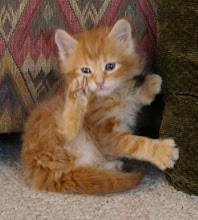Or the internet.
Or a computer, for that matter.
Heck, he had only just become acquainted with this thing called a tail!

His extent of worldly knowledge consisted of Purina Kitten Chow and the inside lining of my hoody. (He considers himself equal parts feline and marsupial.)
In fact, his first encounter with the internet grew out of his wish to discover the origin of his name—(and even after this discovery he still considers “Schrödinger” rather unwieldy for his .6 pound kitten body.)
First, he tried riffling through the index of my physics book, but found that lack of opposable thumbs combined with the 10 pound bulk of University Physics makes this a near-impossible feat. That’s when I consoled him, and explained that the computer keyboard necessitated neither opposable thumbs nor super-kitten strength.
The “puter” amazed Schrödinger more because it was accompanied by a mouse than because it afforded a wealth of information. However, after much cajoling (and resorting to touch-pad use), we navigated to Wikipedia where he read—with my assistance at some of the longer words—a detailed article about Schrödinger’s Cat.
I was impressed by the speed with which he grasped the theory. In case, you don’t feel like muddling through the whole article, I’ll summarize it here. Schrodinger designed this model (“Shrodinger’s cat”) with the intention of showing the paradoxes that arise within Quantum physics. The hypothetical “set-up” consists of a box (hence the title of this blog) holding:
1.) a cat
2.) some radioactive element
3.) a bottle of hydrocyanic acid (poison…)
Now, this box is entirely enclosed, so that no one can observe what happens inside. By chance, some of the radioactive material might decay—or might NOT decay. It’s entirely random. However, if it DOES decay, the particle released starts a chain of events that eventually causes a hammer to drop on the glass bottle, thus releasing the poison.
CAUTION: THE FOLLOWING MAY DISTURB FELINES IN THE ROOM.
In this case, the cat dies. However, Schrodinger proposes that if no observer is present to determine whether or not a particle decayed, there is no way of knowing if the cat is alive or dead. Therefore it is BOTH living and dead, as defined by the law of “superposition.” It’s comparable to the “If a tree falls in the forest…” paradox.
Not long after reading the article, Schro developed a particular wariness of boxes—specifically of his litter box. In fact, he has recently insisted that I observe him use it—just to ensure that he doesn’t “becum ded” in the process.
Schro says that he can relate to the “Observer’s Paradox” particularly well. In fact, he postulates that this is the reason he gets in trouble for climbing up the side of the living room couch.
It works like this….
(Note here, that for convenience’s sake, we are disregarding the radioactive decay as detailed in the original model—though judging from the smell emanating from the litter box, I suspect that there is some nuclear material lurking about…Anyway, back to the couch.
In STATE ONE, no one is home. Let’s say it’s a Monday, during which I have class all day. Schro and the couch are left to themselves. Here, we have two options:
a.) Schro can climb the couch.
b.) Schro can NOT climb the couch.
BUT, according to the theory, if I’m not there to SEE him climb the couch, he is both climbing it and not climbing it at the same time.
For this reason, I am perfectly justified in reprimanding him when I get home.
STATE TWO commences with me walking in the door. I see one of two things:
a.) Schro is climbing the couch.
b.) Schro is not climbing the couch.
Based on my observation, I reprimand accordingly.
Schro’s complaint of the situation is that I reprimand him regardless of his actions in STATE TWO—regardless of how I find him when I come home. Remember, while I was out, he was climbing the couch AND not climbing it simultaneously.
No kitty alibi can hold water against that.
Schro finds this immensely unfair—he plans to act accordingly.

Nevertheless, he has learned to embrace his name—despite it being longer than his body—on the singular condition that he be called “Schro” on most occasions. In fact, he seems quite proud of his name-sake now. I caught him trying on a pair of my dad’s glasses this morning in attempt to cultivate his scholarly air.



No comments:
Post a Comment